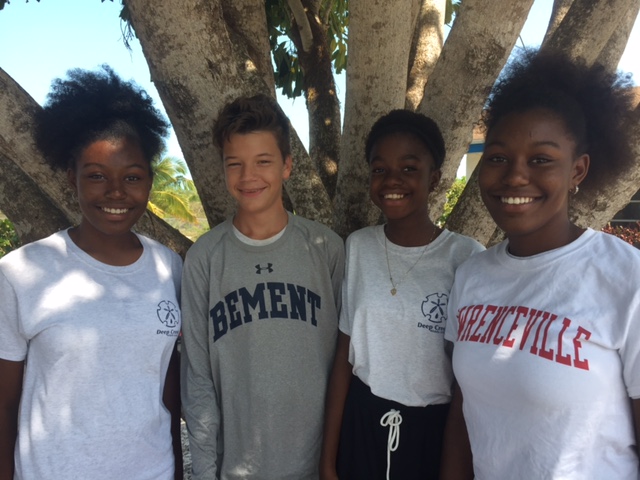During the last week of March, which was blessed with calm winds and clear skies, the reef team had the honor to collaborate with Stephanie Schopmeyer, a returning visiting coral expert from the Rosenstiel School of Marine & Atmospheric Science. Nearly three years ago, Stephanie took a leading role in establishing CEI’s first coral nursery project, located in one of our most popular dive sites – Tunnel Rock. With over twenty years of experience in coral reef restoration, Stephanie helped the CEI reef team in renovating and expanding the current coral nursery. Furthermore, Stephanie continued to share her knowledge and expertise as she helped the team design and implement a brand new staghorn coral (Acropora cervicornis) nursery.
Stephanie Schopmeyer helps the reef team to clean the coral fragments at the nursery site she helped to set up nearly three years ago.
Prior to constructing the new coral nursery, the reef ream had a substantial amount of preparatory work. First, they visited various sites in order to collectively decide on a good location for the new wild staghorn nursery. Once the new nursery site was chosen, the team had to agree on three different wild colonies to collect the respective A. cervicornis fragments from. Stephanie’s professional perspective guided their decision, and three wild colonies were successfully chosen from well known nearby reefs: Schooners, Miller’s Blue Hole, and Bamboo. Forty fragments were collected from Schooners, forty more from Miller’s Blue Hole, and twenty fragments were collected from Bamboo.
Jodie Ball, research technician, collects staghorn fragments from Bamboo reef.
Once all the fragments had been collected from the wild colonies, the team had to anchor down two PVC trees at the designated new nursery site, Bamboo. To ensure the stability of the PVC trees, the team hammered down two metal rebars (one for each tree), which were attached to the PVC tree via a stainless-steel karabiner. The trees were then vertically held afloat by a submerged buoy. Once the trees were secured, the team used mono-filaments and crimps to attach all 100 wild colony fragments to their respective PVC tree branch. The three different genotypes were color-coded for identification purposes. In total, the newly designed A. cervicornis nursery includes one hundred fragments, three distinct genotypes, and two PVC trees with five branches on each.
Reef team intern, Daisy Buzzoni, attaches staghorn coral fragments to a PVC tree at the new nursery site.
Reef team intern, Annie MacCarthy, records measurements of the coral fragments at the new nursery site.
The next steps of this project will focus on monitoring the wild coral populations from which the four collected genotypes came from. The Reef Team will apply AGRRA and FRRP methods by taking measurements including maximum length, width and height so that an ellipsoid volume can be estimated. Additionally, the measurements of the total linear extension will be recorded as well as the total number of branches, apical polyps, partial mortality, and any other identifying factors (bleaching, etc) will be documented.
The newly established nursery serves as part of a network of coral nurseries throughout the wider Caribbean region, with the purpose of propagating a healthy and sustainable stock of staghorn coral for use in coral reef restoration. Furthermore, these corals provide unique scientific opportunities to study the growth and productivity of this threatened species.
*All photos courtesy of Daisy Buzzoni, reef team intern.
